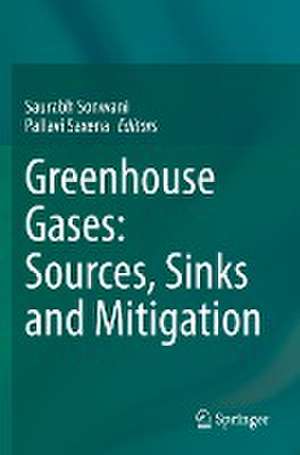Greenhouse Gases: Sources, Sinks and Mitigation
Editat de Saurabh Sonwani, Pallavi Saxenaen Limba Engleză Paperback – 23 ian 2023
| Toate formatele și edițiile | Preț | Express |
|---|---|---|
| Paperback (1) | 1106.93 lei 6-8 săpt. | |
| Springer Nature Singapore – 23 ian 2023 | 1106.93 lei 6-8 săpt. | |
| Hardback (1) | 1115.46 lei 3-5 săpt. | |
| Springer Nature Singapore – 22 ian 2022 | 1115.46 lei 3-5 săpt. |
Preț: 1106.93 lei
Preț vechi: 1349.92 lei
-18% Nou
Puncte Express: 1660
Preț estimativ în valută:
211.81€ • 230.80$ • 178.48£
211.81€ • 230.80$ • 178.48£
Carte tipărită la comandă
Livrare economică 23 aprilie-07 mai
Preluare comenzi: 021 569.72.76
Specificații
ISBN-13: 9789811644849
ISBN-10: 9811644845
Pagini: 257
Ilustrații: XVI, 257 p. 1 illus.
Dimensiuni: 155 x 235 mm
Greutate: 0.39 kg
Ediția:1st ed. 2022
Editura: Springer Nature Singapore
Colecția Springer
Locul publicării:Singapore, Singapore
ISBN-10: 9811644845
Pagini: 257
Ilustrații: XVI, 257 p. 1 illus.
Dimensiuni: 155 x 235 mm
Greutate: 0.39 kg
Ediția:1st ed. 2022
Editura: Springer Nature Singapore
Colecția Springer
Locul publicării:Singapore, Singapore
Cuprins
Chapter 1. Introduction to Green House Gases: Sources, Sinks and Mitigation.- Chapter 2. Source Apportionment of Greenhouse Gases in the Atmosphere .- Chapter 3. IDENTIFICATION OF MAJOR SINKS OF GREENHOUSE GASES.- Chapter 4. Greenhouse Gas Emission Flux from Forest Ecosystem.- Chapter 5. EFFECT OF GREEN HOUSE GASES ON HUMAN HEALTH.- Chapter 6. Air Pollution and Greenhouse Gases Emissions: Implications in Food Production and Food Security.- Chapter 7. Optimization of Greenhouse Gas Emissions through Simulation Modeling: Analysis and Interpretation.- Chapter 8. ROLE OF BIOMASS BURNING IN GREENHOUSE GASES EMISSION.- Chapter 9. Ozone Impacts and Climate Forcing: Thailand as a Case Study.- Chapter 10. Role of Nanotechnology in Combating CO2 in Atmosphere.- Chapter 11. Mitigation Strategies of Greenhouse Gas Control: Policy Measures.
Notă biografică
Saurabh Sonwani is currently working as Assistant Professor at Department of Environmental Studies, Zakir Husain Delhi College, University of Delhi. Till now, he has eight years of research and three years of teaching experience in the field of Environmental Sciences. He has been awarded Ph.D. from School of Environmental Sciences, Jawaharlal Nehru University, New Delhi & worked in the field of Atmospheric Chemistry. He has been awarded a CSIR-JRF in the subject of Earth, Atmospheric, Planetary and Ocean Sciences. He has published several research papers, book chapters and books in highly reputed journals/publishers in the areas of Air Pollution and Environmental Health. He is currently associated with TOAR-IGAC project as a member and co-author in publications. He is serving as an Associate Member of APSI, EnviroComp Institute, USA. He is also an active member of iLEAPS community, UK from South Asia and Middle east Region working for early career scientist.
Pallavi Saxena is an Assistant Professor, Department of Environmental Science, Hindu College, University of Delhi. She has been awarded DST Fast Track Young Scientist Award at SES, Jawaharlal Nehru University, New Delhi. She has completed her Postdoc from SPASC, Physical Research Laboratory, Ahmedabad, India. She has been awarded Doctor of Philosophy in Environmental Studies from the University of Delhi on ‘Effect of Photochemical Pollutants on Plant Species’. Her area of interest is air pollution and plant physiology. She is elected as Chair of South Asia and Middle East Region of ECR, iLEAPS, UK. She has also been a co-author and collaborator from India in TOAR from 2015 onwards. Till now, she has published about 45 research publications in journals/books in Atmospheric Science and published 4 books in the field of Air Pollution and Plant Health in Springer and other publishers. She is also an Advisory Board Member of APSI, USA.
Textul de pe ultima copertă
This book begins with a brief background on greenhouse gases sources and sinks and continues with a discussion in different sectors including forest fluxes to human health and modeling techniques to policy measures. The chapters explore in detail about the GHG emission budgets, mitigation strategies, technical advancement and input-output analysis. Greenhouse gases (GHGs) occur naturally in our atmosphere and are essential to the survival of most of the organisms on the planet earth. GHGs such as such as carbon dioxide, methane, nitrous oxide, and ozone etc. play a major role in balancing the radiative budget, by absorbing or emitting some of the infrared rays reflecting from the earth’s surface. But unfortunately, anthropogenic activities like use of fossil fuel, intensive agriculture and livestock farming, use of synthetic fertilizers, deforestation, and industrial processes etc. have drastically interfered in the natural air composition, by releasing excess greenhouse gases into theatmosphere. This has led to the increase in the ability of the atmosphere to absorb more infrared energy. This book is a complete information set covering all aspects of GHGs, sources, sinks and control/mitigation strategies. This book is also written in simple language with helpful photographs, diagrams and flowcharts which will make the reader comfortable in understanding the concepts a more relatively easier way. The book is a valuable tool for students in Environmental Science, Ecology, Biological Science, Economics and Agriculture. It is unique to environmental consultants, researchers and other professionals involved in climate change studies, Non-governmental organizations (NGO’s).
Caracteristici
Covers all aspects of GHGs as sources, sinks and mitigation strategies Supports curriculum for graduate and post graduate courses in environmental sciences Explains the uses of modelling tools in management of GHG
